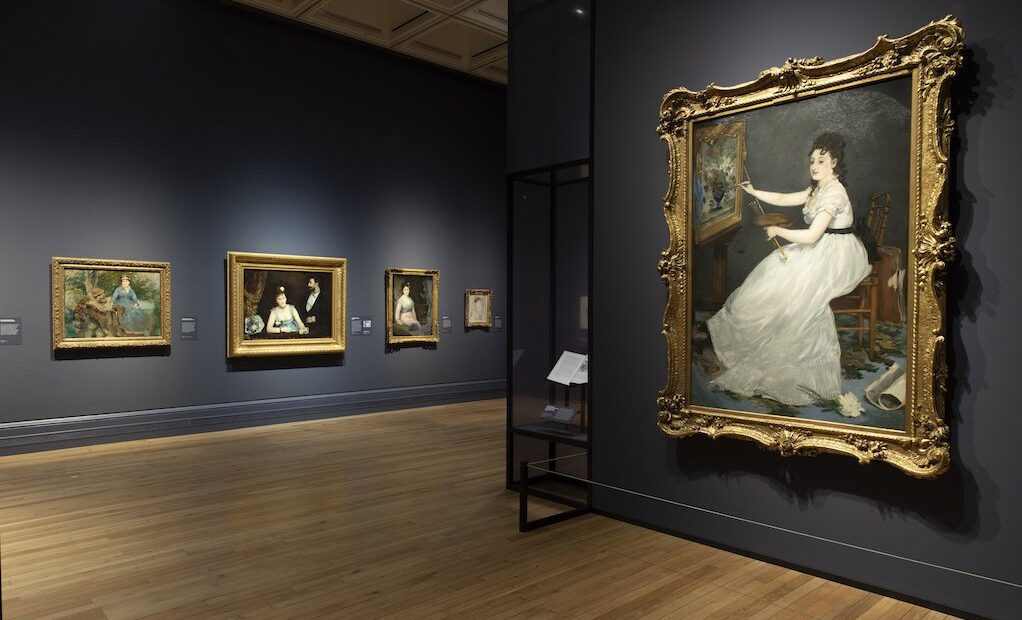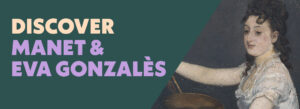Discover Manet and Eva Gonzalès at the National Gallery

In 1869, 22-year old-French painter Eva Gonzalès became a mentee of her compatriot, Édouard Manet. The National Gallery’s exhibition, Discover Manet and Eva Gonzalès provides an opportunity for the traditionally framed one-directional nature of that artistic influence to be questioned. It is the first of a series of exhibitions in the Sunley Room that will take a single painting and explore that work in conjunction with associated pieces. Here one finds Manet‘s Eva Gonzales, a portrait of his talented young understudy from 1870, taking up that role.
All of the works featured in this proportionally modest, but illuminating exhibition are part of the so-called Hugh Lane bequest, a gathering of paintings shared between the National Gallery and the Hugh Lane Gallery in Dublin. Manet’s huge portrait of his protégée is striking, if a little idiosyncratic. Eva Gonzalès is depicted sitting before an easel painting in an elegant white dress – surely inappropriate attire for any artist wielding a paintbrush. The National Gallery has managed to identify the subject of her own canvas as a copy of Jean-Baptiste Monnoyer’s 17th century Blue Vase. She gazes out, but, rather than directly engaging with the viewer, her eyes are drawn to her left. When the work was shown at the Paris Salon of 1870, some critics mocked the “dazed, fixed expression” the artist had given her, whilst comparing the rendering of her nose to that of a parrot. Another friend of Manet’s, the painter Berthe Morisot, claimed the artist had made 25 attempts to capture Gonzalès’s likeness. Indeed x-rays have brought to the surface the extent to which Manet carried out numerous changes at odds with his reputation for quick, flat brush strokes that paved the way for Impressionism.
As far as the white dress is concerned, some have condemned Manet for painting Gonzalès as an attractive young woman first and as an artist in her own right second. A white peony on the floor echoes both the colour of the woman painter’s dress and porcelain skin. And yet the bulging artist’s portfolio Manet positions behind her attests to his respect for Eva’s own practice, as does, of course, the fact she is depicted at work in the first place. There is also the oddity of a gold frame being included by Manet around the floral study his friend is painting – then considered a suitable subject for a woman artist – despite the fact the work has yet to be completed. He may well be commenting on the way society’s mores were constricting female creativity.
This exhibition offers considerable evidence of the artistic dialogue that took place between Édouard Manet and Eva Gonzalès. She was the artist’s only official mentee and showed her work alongside his, including at the Paris Salon. One finds her highly impressionistic painting, A Theatre Box at the Italiens (1874), relating to Manet’s Couple in a Theatre Box pastel drawing of the same year. Intriguingly, her works were often better received by critics than his; Manet’s portrait of Gonzalès was widely derided. Elsewhere, one continues to see them both taking on scenes from everyday life, seemingly bouncing ideas off each other. Eva’s Donkey Ride (1880) would seem in part to owe something to Édouard’s portrait of Carolus-Duran in riding boots from four years earlier.
The National Gallery throws into sharp relief the obstacles female artists encountered during the 19th century with their educational possibilities restricted. Furthermore, the tradition of women’s portraiture from the 18th to early 20th century is being explored here: there’s a superb self-portrait by Elizabeth Vigée Le Brun, where she grandly wears pink silk;. Angelica Kauffmann (one of the first female members of London’s Royal Academy) depicts herself in a white gown. Their decision to paint themselves in such impressive dress would seem a deliberate declaration of their own standing. From more modern times one finds a rather spirited self-portrait by Gwen John and Dame Laura Knight’s Self-portrait with Nude from 1913. The latter shows her deep resentment for the ridiculous rule that forbade her as a female art student from painting directly from the nude model. Ultimately, this insightful exhibition sets the portrait of Eva Gonzalès in a broader context and offers us the chance to reassess these works with a fresh eye, bursting a few patriarchal bubbles along the way.
James White
Discover Manet and Eva Gonzalès is at the National Gallery from 21st October until 15th January 2023. For further information visit the exhibition’s website here.


























Facebook
Twitter
Instagram
YouTube
RSS